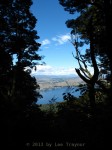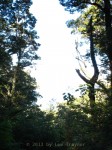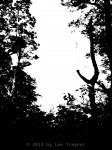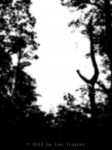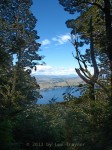A major drawback of digital photography, and one that I have been aware of all along, is the lack of dynamic range, the difference between how dark is going to finish up as black, and how light will result in pure white. The closer these two values are, the greater the contrast, but there will be no detail visible in light or dark sections. The eye and its brain have an extraordinary dynamic range which allows us to see details both in the very dark and the very bright at the same time.
However, digital photography also offers a way out. Since the shots themselves are dirt cheap, why not take a couple of shots at different exposures to allow detail in the very darkest and brightest regions to be recorded and then combine the images. The very simplest (and most simplistic) way of achieving this is to take one over- and one under-exposed shot. In the GIMP use a copy of the overexposed shot to make a pure black-and-white picture (via Colors → Threshold), blur it and use it as a layer mask for the underexposed shot. The white areas of the mask will show regions of the overexposed shot, whereas the black areas will come from the underexposed one. Not a bad result for a start.
But all was not well. To begin with, I noticed even as I was taking this pair of shots that even with a tripod it was impossible to take two absolutely identical shots, because pressing the shutter rotated the camera ever so slightly. Coming down from Limestone Bluffs, where these shots of Te Anau were taken from in late February, 2009, I teamed up with an animationist from New York. Spotting my tripod he enquired what I was up to and I told him my woes. His suggestion: Use the Self-Timer to get a hands-free, stabilised shot. Duhh!
My friend got his reward, though, as he wanted to know what particular bird he had spotted. “That boid” was a New Zealand Wood Pigeon. So we both got something out of it.
The next problem that arose was that even with the tripod and the self-timer, the shots needed to be registered ever so slightly; barrel distortion had to be removed from the images to make the registration more accurate; and some means of automating the process had to be found.
Just a few days after this encounter I was on the Milford Track enjoying unseasonable sunshine and clear skies on the way up and down the Mackinnon Pass. On the way back to Mintaro Hut I stopped to take a bracket of the upper Clinton Valley, one half in sunshine, the other in deepest shadow of the mountain. Only: I didn’t stop at two exposures, I took a total of five. At the time I had no way of combining them. These were truly shots in the dark.

